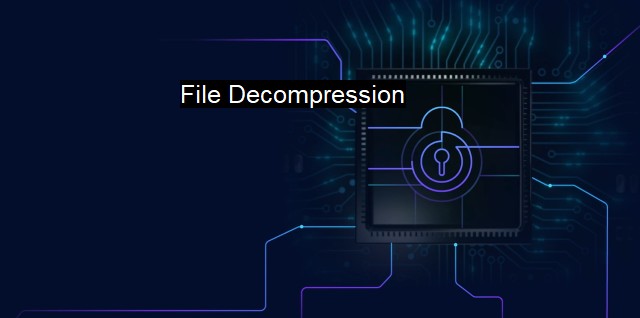What is File Decompression?
The Risks and Benefits of File Compression and Decompression in Cybersecurity: An In-Depth Look
File decompression is an integral part of file management and cybersecurity procedures. This term relates to the way compressed files are reverted to their original, full format. When a file is compressed, its size is reduced through various algorithmic mechanisms to create a version with the same content but smaller dimensions. The reversible process of restructuring a compressed file back to its original state is what is known as file decompression.Computers draw several benefits from file compression and decompression processes. For instance, compressing files can help to save storage space on the hard drive or to speed up the transfer of large or multiple files across the internet. Similarly, once these smaller, lighter versions reach their destination, they can be decompressed or expanded to their original structure, giving rise to a form of space management and remote file management system.
Although file decompression has these notable benefits, it encounters its main challenge within the realm of cybersecurity. Viruses, malware, and other harmful elements can be stored in these compressed files, going unnoticed and silently infecting systems for extended periods. Security mechanisms usually scan files, but decentralized archives or compact files can inhibit this simultaneous scanning process, allowing harmful elements to slip under the radar.
The antivirus industry has developed multiple methods to mitigate this risk, every antivirus program having unique abilities to manage compressed files. Some programs automatically decompress and inspect the contents of these files, checking them for potential danger before they're executed or opened. These security measures require the application to utilize a significant portion of a system's resources, but they're worth the investment to ensure enhanced cybersecurity.
For other antivirus programs, there's possesses the setting where users can decide whether or not an automatic decompression should occur. Users have the option to choose if they receive a prompt whenever a compressed file needs decompressing, whether it’s instant, whether or not the system divides the compressed file into inspection-ready blocks, or allow it to be inspected only when required. Users can toggle between scanning all compressed files, only files with particular extensions, or exclude specific files from the inspection process.
It’s important to note that even if an antivirus software is equipped to automatically decompress and scan archives, the process can sometimes fail, not due to defects of the antivirus software, but due to how compressed files are often multi-layered. A compressed file might contain another compressed file several tiers deep. Some malware authors use this method, knowing that the further down the compressed file is, the less likely it is for an antivirus to reach it.
To circumvent these vulnerabilities in file decompression, many defense subsystems employ preemptive measures. The solution primarily revolves around limiting how "deep" antivirus systems will automatically decompress and scan the files. Despite this restrictive approach, these preemptive measures allow for a more complete and secure inspection.
File decompression may appear as a simple task. It is a core aspect of file management and aids virus detection. It spells an operational dilemma, one that forces the decisive balance between saving system resources, protecting the computer from potential threats, and ultimately controlling the fate of compressed archives. sound file decompression practices, coupled with strict inspection and scanning procedures, plays a paramount role in maintaining safe digital spaces.
In short, while file decompression inherently possesses its security shortcomings, adequate measures can mitigate these risks. The appropriate implementation of antivirus capabilities with the understanding of the nature of file compression and decompression forms the basis of effectual cybersecurity practices.

File Decompression FAQs
What is file decompression and how does it relate to cybersecurity and antivirus?
File decompression is the process of extracting compressed files. Cybersecurity and antivirus software often use file compression as a way to reduce the size of files, but compressed files can also be used by hackers to hide malware. File decompression plays a key role in identifying and removing malicious files from a system.What are some common file compression formats found in cybersecurity and antivirus software?
Some common file compression formats used in cybersecurity and antivirus software include .zip, .rar, .7z, and .tar.gz. These formats can be used to compress and extract individual files or entire folders.What are some best practices for decompressing files safely in a cybersecurity context?
Some best practices for decompressing files safely in a cybersecurity context include scanning the file with antivirus software before decompressing it, using a trusted and reputable file decompression tool, checking the file for any suspicious or unexpected file extensions, and avoiding opening compressed files from unknown or suspicious sources.Can file decompression cause security vulnerabilities?
While file decompression itself does not typically cause security vulnerabilities, it can reveal vulnerabilities in other software components. For example, if a decompressed file contains malicious code that takes advantage of a vulnerability in an operating system or application, the decompression process could trigger the exploit. It is important to keep all software up-to-date and to follow best practices for safe file decompression to minimize these risks.| | A | | | B | | | C | | | D | | | E | | | F | | | G | | | H | | | I | | | J | | | K | | | L | | | M | |
| | N | | | O | | | P | | | Q | | | R | | | S | | | T | | | U | | | V | | | W | | | X | | | Y | | | Z | |
| | 1 | | | 2 | | | 3 | | | 4 | | | 7 | | | 8 | | |||||||